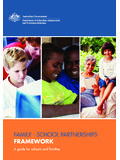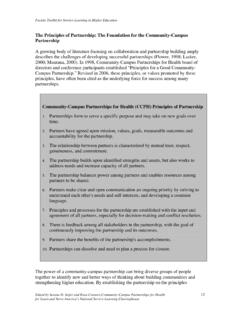Transcription of The Benefits and Challenges of Collaborative Multi-Agency ...
1 Cheminais-Ch-02 9/22/2008 5:47 PM Page 23. 2. The Benefits and Challenges of Collaborative Multi-Agency working This chapter describes: The latest research findings on how schools are implementing ECM and engaging collaboratively with other services and agencies The Benefits of Multi-Agency partnership working within educational settings The Challenges faced by educational settings in establishing and developing Multi-Agency partnership working Positive ways forward in meeting the Challenges and building the Multi-Agency team This chapter is suitable for those who are researching Multi-Agency working .
2 Recent research into Every Child Matters and Multi-Agency working Engagement in Every Child Matters is necessary because the intrinsic links between the educational setting, services, agencies and the community help to improve the educational achievement, the health and the social choices of children, young peo- ple and their families. The government continues to encourage schools and other educational settings to collaborate with each other and with outside agencies and organizations, in order to deliver the five ECM outcomes. One local authority strategic manager commented in a recent NFER report on the value of social care professionals working in extended schools: ECM has been the tool that people can identify with and say, well, although I sit in health or social care, or extended schools, I have a part to play and it is actually coming from the Government' (Wilkin et al.)
3 , 2008: 9). There have been a number of research studies and surveys on the implementation of the Every Child Matters agenda in schools, and how they are responding to the need for greater partnership working with other services and agencies. Cheminais-Ch-02 9/22/2008 5:47 PM Page 24. 24 EFFECTIVE Multi-Agency PARTNERSHIPS. The National Foundation for Educational Research in two annual surveys of trends in education 2006 and 2007, reported on how the Every Child Matters agenda was affecting schools. Both surveys identified the following main changes occurring as a result of schools engaging with Every Child Matters.
4 School improvement planning reflecting the five ECM outcomes review of the curriculum and current school practice review of staffing and recruitment in school to align ECM with workforce remodelling marked growth in partnership involvement and information sharing increased extended school work improved school meals and greater awareness of healthy eating and healthy lifestyles The two NFER surveys on ECM also identified the same Challenges facing schools, in delivering the Every Child Matters agenda. These were: financial issues, particularly in relation to sustainability of resources having sufficient time to develop and implement the ECM agenda developing closer collaboration with other services and agencies involved in supporting children and young people's well being.
5 The NFER surveys of 2006 and 2007 both found that schools had more contact with some local services than others. For example, 90 per cent of primary and secondary schools surveyed accessed health, social care and the police more than housing services which were accessed by only 41 per cent of primary schools and 50 per cent of secondary schools. Housing and social care were the two services which were considered to be the least accessible for support by schools. The General Teaching Council published a report in autumn 2007 on Every Child Matters and the Children's Workforce in schools (GTC, 2007a).
6 In relation to Collaborative working between schools and Multi-Agency front-line practitioners the report highlighted the need for the following: sufficient well-trained, high-quality front-line practitioners from services and agencies with the capacity to respond effectively to the ECM agenda in order to deliver preventative interventions greater opportunities for more inter-professional learning, training and devel- opment between school staff and Multi-Agency practitioners working directly with pupils in the school to improve integrated working inter-professional training in using inter- agency frameworks and protocols, that is, National Service Framework, (NSF)
7 , the Common Assessment Framework, ContactPoint Cheminais-Ch-02 9/22/2008 5:47 PM Page 25. THE Benefits AND Challenges OF Collaborative Multi-Agency working 25. the time to invest in building quality relationships between school staff and Multi-Agency front-line practitioners clearer and improved information for schools on where to refer children to and who to seek specific expertise from more up-to-date information about voluntary sector provision available more information and a clearer understanding about the expertise, role, procedures and processes of children's services and agencies working with schools opportunities to get together and work with colleagues from other services to develop an analysis of local needs which can be addressed collaboratively greater sharing of exemplification of good practice in how to implement ECM.
8 And Multi-Agency partnership working in educational settings more support for educational settings in relation to accountability for monitoring and evaluating the impact of Multi-Agency interventions and support on improving pupils ECM well-being outcomes. Harris, A., et al., reported on Understanding the Reasons why schools do or do not fully engage with the ECM/ES agenda, on behalf of the NCSL and TDA. Their report findings confirmed those of the NFER and the GTC, in the need for: greater clarity of purpose in connection with other agencies schools establishing and consolidating links with partners and other agencies schools creating a shared vision, purpose, goals with other agencies a common understanding of the professional language used across different multi -professional disciplines schools establishing a clear line of communication.
9 Accountability and decision making with other agencies greater involvement of outside agencies on the school's leadership team whole-school staff training on strategies for fostering Multi-Agency ways of working together shared evaluative feedback existing between schools and multi -agencies a clear understanding of the respective roles and responsibilities of partners and agencies in the implementation of ECM. sufficient local authority support to facilitate and secure Multi-Agency inputs for schools, including ring-fenced funding to develop and cement such partnership working designated staff in schools to have the time to co-ordinate the wide-ranging Multi-Agency partnerships for delivering ECM.
10 Cheminais-Ch-02 9/22/2008 5:47 PM Page 26. 26 EFFECTIVE Multi-Agency PARTNERSHIPS. school leaders to focus more on interrelationship building, Collaborative work- ing, Multi-Agency leadership, in becoming more politically astute, in order to re-engineer and transform cultural, professional and organisational boundaries and practices. The Benefits of Collaborative Multi-Agency working There are many Benefits of Multi-Agency Collaborative partnership working for educational settings. Every Child Matters is the gel' that holds partnership working together, and the value it adds contributes immensely to improving the learning and well-being outcomes of children and young people.
















